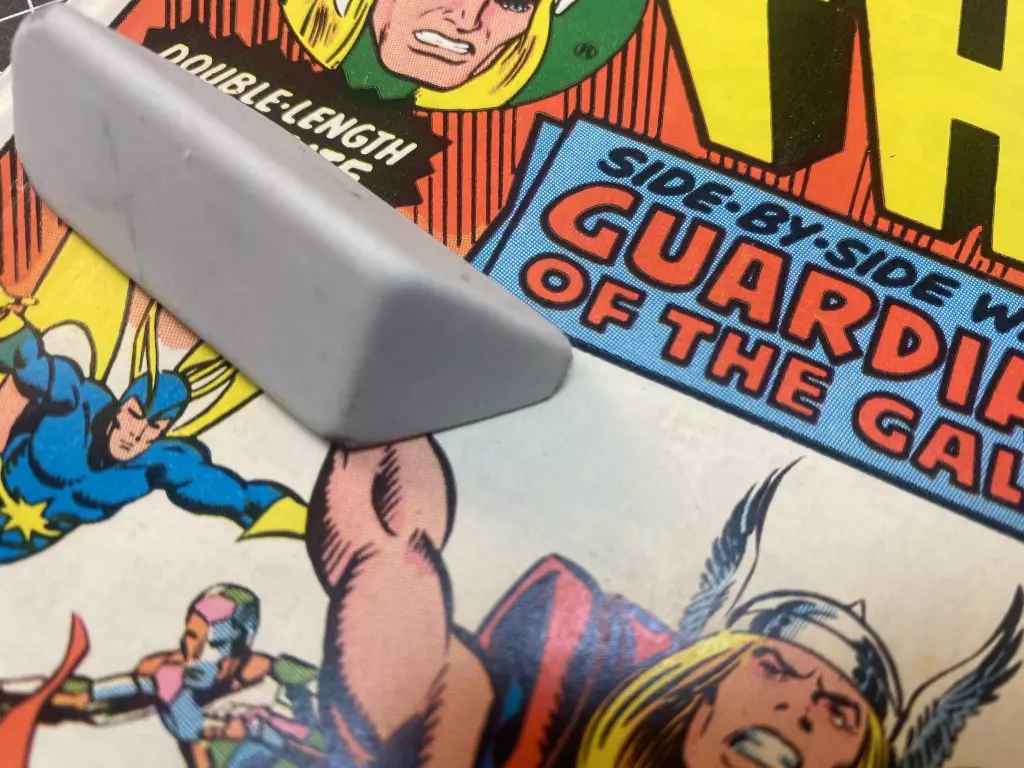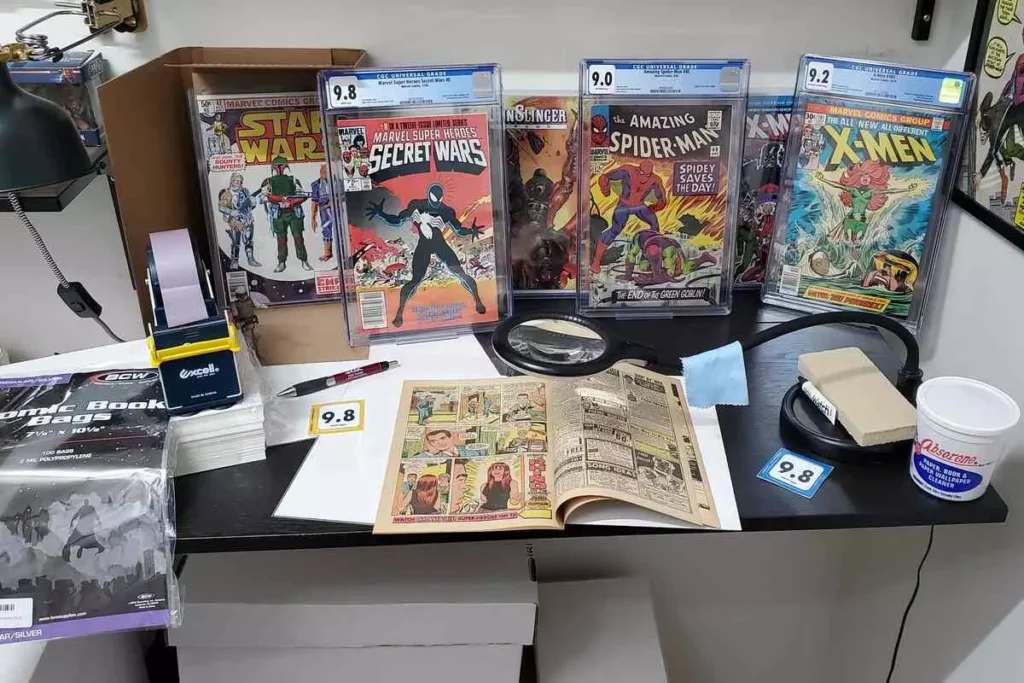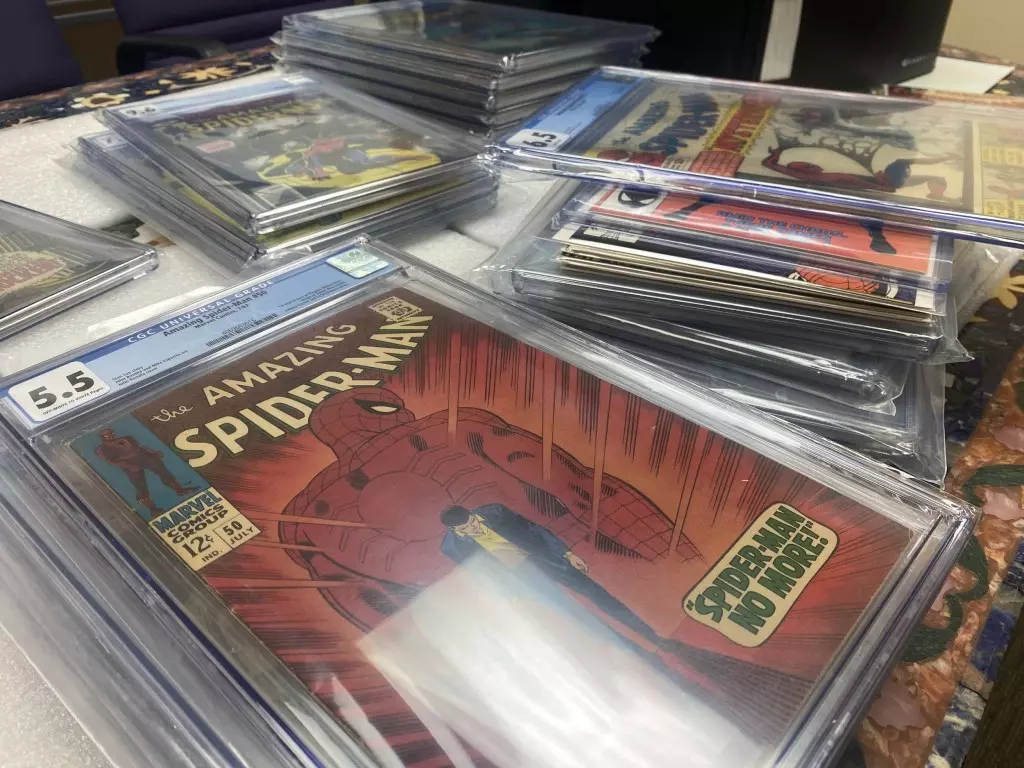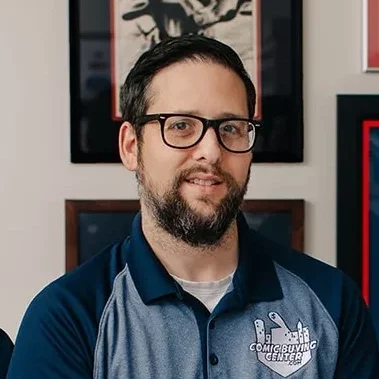For newcomers in comic book collecting, understanding the importance of comic book pressings and cleaning is an important thing. These preservation techniques are not just about the look of your comics, they’re about protecting and maintaining the value. Pressing comics can remove non-color breaking creases and other defects, potentially making the appearance and grade of a book better. Cleaning can rid your comics of surface dirt and other contaminants that, over time, could degrade the paper quality. Both processes require a careful, skilled hand to ensure that the comic’s integrity isn’t compromised. But if you don’t have a skilled hand yet – no worries, we have a thing or two to recommend.
What is cleaning and pressing?
Think of comic book cleaning and pressing as spa treatment for people. It helps your comic books look better. Cleaning removes surface dirt and minor stains, making the pages and covers bright and fresh. Pressing is a careful process that flattens out wrinkles, creases, and bends, giving the comic a smoother, more pristine appearance. It’s a bit of care that can sometimes improve the overall grade of the book, which is especially important if you’re thinking about selling or just want your collection to be in the best shape. Too much pressure or the wrong technique can do more harm than good though.
How to clean comic books?
Here’s a simple guide to cleaning comic books, which can help in preserving them:
- Prepare Your Space. Ensure a clean, flat surface to work on.
- Dry Brushing. Gently brush the cover and pages with a soft, dry paintbrush to remove surface dust.
- Soft Eraser. For pencil marks, lightly use an art gum eraser.
- Absorbent Powder. For greasy stains, sprinkle a small amount of absorbent powder, let it sit, then brush away carefully.
- Cloth Use. Tackle fingerprints with a soft, dry microfiber cloth by lightly dabbing or rolling over the spots.
Also remember:
- Always handle your comics with clean hands to avoid transferring oils.
- Do not use water or chemical cleaners, they can damage the paper and inks.
- If your comics are particularly valuable or fragile, consider consulting a professional for cleaning and preservation.
Remember, gentleness is the key. Don’t rub or press hard, and if you’re ever in doubt, it’s better to seek professional help than risk damaging your comic. And remember – clean comic books look better and may cost more in case of resale.
Can you clean and press comics yourself?
Sure, you can clean and press comics yourself, but it’s a bit like doing your own plumbing – it can save you money, but it requires care and the right tools. Cleaning is about wiping away dirt without damaging the ink or paper. Comic pressing can be trickier though, it’s about using heat and pressure to smooth out creases and wrinkles. It’s usually done with a specialized comic book press, but some adventurous souls use home methods with varying results. Pro tip: don’t use iron, it isn’t worth it. If you’re trying DIY, do thorough research and maybe practice on less beloved copies or just some cheap magazines you don’t care about. For rare or valuable comics, though, it might be safer to leave it to the professionals. After all, you don’t want to turn your prized edition into a sad origami project!
How much does professional pressing cost?
Professional comic book pressing services offer a range of prices depending on various factors. Here are a couple of examples from professional U.S. companies:
- CGC offers comic book pressing technique for modern comics (1975 and later) starting at $25, with an FMV of $400 or less. For comics with an FMV between $400-$999 of any age, the economy service is around $40. They also provide a service for comics with an FMV of $1000 or more, which is a percentage of the value of the comic.
The cost can be influenced by several factors, including the overall value of the comic book, the complexity of the defects being corrected, and how quickly you need the comic book returned to you. For detailed pricing and services, it’s best to contact CGC directly or visit their websites.
Should you get your comics cleaned and pressed?
Yeah, getting your comics cleaned and pressed can be a great choice, especially if you’re looking to upgrade their appearance or prep them for grading. Think of it like giving your comics a little facelift, a facade repair. Cleaning gets rid of surface dirt and smudges, making them look fresher and more vibrant. Pressing can smooth out those annoying creases and folds, potentially bumping up their grade if you decide to submit them for professional grading later on.
But, it’s not always necessary for every comic in your collection. If you’ve got some valuable issues or ones you hope to sell, investing in cleaning and pressing can definitely add value. For your everyday reading comics, though, comic book cleaning and pressing might be overkill. Just weigh the cost against the potential benefits, and if it makes sense for your prized issues, go for it!
Collector tips for comic book care
Taking care of your comic books doesn’t have to be a daunting task. Here are some simple tips to keep them in top shape:
- Handle with Care. Always have clean, dry hands and a clean space when reading or sorting your comics.
- Storage is Key. Use acid-free bags and boards, and store them in a cool, dry place away from direct sunlight.
- Avoid Pressure. Don’t stack comics too high. Use comic boxes to prevent bending. Stacking a few won’t harm, but if you stack a dozen…
- Be Gentle. Never bend or fold pages. Use a bookmark instead of folding corners.
- Stay Organized. Keep an inventory of your collection to avoid unnecessary handling.
Remember, a little bit of attention can go a long way in preserving the value and appearance of your comic books! But if something happened, or your comic books are just too old – professional cleaning and pressing is a perfect choice, especially if you decide to sell comic books later on.
-
Pete Przysiezny, owner of Comic Buying Center, has been buying and selling comics and collectibles for over 30 years. He lives in Northern Illinois and specializes in buying large comic book collections. He has a vast knowledge of all eras and types of comic books ranging from the 1930s to the 2000s. Pete spent his childhood going to comic book conventions with his father, so you could say he was raised in the industry.




